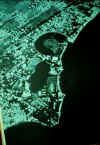![]()
Click on thumbnail for larger image.
The double harbor of CARTHAGE. Founded in 814 BC by Phoenician princes, Carthage emerged as the leading maritime power of the western Mediterranean, ultimately coming into conflict with the Roman Republic during three Punic Wars, 264-241 and 218-201, and its ultimate destruction by Rome in 146 BC. Carthage's wealth depended not only on its mercantile activities but also on its rich agricultural hinterland, from which food supplies were exported to the urbanized Greek East. The outer harbor (below) was the commercial harbor; the inner harbor, heavily defended, was the naval harbor complete with shipsheds and a central "island" with coning tower where the generals could direct naval preparations.
The SLAVE MARKET AT DELOS: according to the geographer Strabo, in 166 BC the Romans converted Delos into a duty-free port where Italian traders came to purchase tens of thousands of slave prisoners from the Cilician Pirates. The trading community was attacked twice by Mithradates and the Cilician Pirates and essentially abandoned after 69 BC. The Warehouse of the Columns at Delos, shown here, 60x40 meters and double storied, possessed long open corridors, axially aligned doorways, and retractable tables able to accommodate such commerce. Prisoners and other goods could be offloaded from ships directly outside, directed through the building's corridors and aucthioned in the interior courtyard.
The FORUM OF POMPEII, an average Campanian harbor town that harbored resort villas for members of the Imperial bureaucracy, Pompeii became destroyed by the eruption of Mt. Vesuvius in 79 AD. Covered in volcanic ash and abandoned, its remains provide a clear glimpse of life in the Roman Empire.
FORUM ROMANUM, the Republican Forum of Rome. From left to right the Basilica Julia (c. 44 BC), Temple of Saturn (5th Century BC), Temple of Divine Vespasian (1st Cent. AD), Temple of Concord (2nd Cent. BC), Triumphal Arch of Septimius Severus (early 3rd Cent. AD). Directly behind, the Tabularium or archive house (1st Cent. BC), and in the distance, upper left, the Temple of Jupiter Optimus Maximus on the Capitoline Hill (6th Cent. BC.
The CILICIAN PIRATE BASE on the Kragos Mountain, later resettled as Antioch on the Kragos, c. 139-67 BC. Arisen from renegade maritime warriors during the dynastic disputes of the Seleucid dynasts of Syria, the pirates rapidly amassed forces of 1000 warships and 30,000 combattants. With the assistance of King Mithradates VI of Pontus, they ruled the seaways of the Mediterranean, from Syria to Spain, during the early first century BC. The Romans finally dispatched their general, Cn. Pompeius Magnus, with the sweeping authority of an extraordinary command to eradicate the pirates in a campaign completed in 90 days. Pompey defeated the last of the pirate armada in the waters before this promontory in 67 BC.
The Harbor of ALEXANDRIA EGYPT. The capital of Ptolemaic Egypt, famous as a cultural center as well as for its library of a million volumes, Alexandria became second largest city in the Roman empire and port of origin for the imperial grain fleet that feed the burgeoning capital of Rome. Its population rivaled that of Rome at 1 million inhabitants.
actual model
The IMPERIAL FORA at Rome: to accommodate the requirements of Mediterranean empire, the emperors of early Rome expanded the monumental center of the city by reclaiming delapidated ghetto regions east of the Forum Romanum to create new esplanades, temples, and market centers. From Left to Right these include: The Forum of Trajan (86-118 AD) with its Temple of Divine Trajan and Basilicia Ulpia; The Forum of Julius Caesar (Dictator in 44 BC) with its Temple of Venus Genetrix; the Forum of Augustus (27 BC-14 AD) with its Temple of Mars Ultor; the Forum Transitorium, constructed by the Emperor Nerva (96-98) with its Temple of Minerva, and the Forum and Temple of Peace constructed by Vespasian (69-79).







